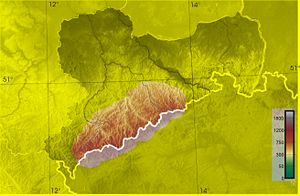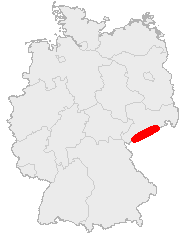Erzgebirge
| Erzgebirge | |
| Ore Mountains, Krušné hory | |
| Range | |
 Physical map
|
|
| Country | Germany, Czech Republic |
|---|---|
| Region | Saxony (Germany) |
| Highest point | Klínovec (Keilberg, 1244 m) |
| Geology | Paleozoic sedimentary, metamorphic and magmatic rocks |
| Orogeny | Variscan |
 |
|
The Erzgebirge (German, Czech: Krušné hory) or Ore Mountains are a mountain range, which for many centuries formed a natural border between Saxony in Germany and today's Czech Republic, named in both local languages after the ore found there. The mountain range forms the border between both countries for 150 kilometers, extending from the western border of Saxony to the Elbe river.
The western portions of the Erzgebirge have the highest peaks, with Klínovec (Keilberg, 1244 m) on the Czech side and Fichtelberg (1214.6 m) on the German side being the highest mountains of this range. In the west the Ore Mountains adjoin the lower Bavarian Fichtelgebirge. In the east, the Elbe Sandstone Mountains on both banks of the Elbe river may be regarded as the easternmost extension of the Erzgebirge. East of the Elbe, the mountain chain continues as the Lusatian Mountains. While the mountains slope gently away to the north, where the cities of Zwickau and Chemnitz are located in the foothills, the southern incline is rather steep.
The Erzgebirge was virtually unsettled during the Middle Ages and covered with dense forests. In the fifteenth century the discovery of silver and tin ore deposits led to the settlement of the mountains and the foundation of cities. Due to the richness in mineral resources, including fluorspar, iron, copper, cobalt and uranium, as well as silver and tin, the German-speaking population which until 1945 lived on both sides of the mountains called them Erzgebirge, which literally means "metal ore mountain range". Silver found in Joachimsthal was used to mint coins known as Joachimsthaler or Thaler, from which Dollar is derived. Later uranium was found there. After World War II, Soviet experts searched for remains of the German nuclear energy project to support the Soviet atomic bomb project. A mining company called SDAG Wismut (named after bismuth, de:Wismut (Unternehmen)) operated until the fall of communism, causing environmental damage.
As the ore deposits and the related business often declined, former miners had to look for new ways to feed their families. In addition to lace making and weaving, the inhabitants went into wood carving, producing toys and religious figures. Thus, the Erzgebirge region became famous for many Christmas traditions. Nutcrackers, "smoking men", "Christmas pyramids" (carousels with figures of the Christmas story or from mining) and Schwibbogen (wooden arcs with candles in the windows, representing a mine entrance) are some of many Christmas goods made in the Ore Mountains. Seiffen in the East Ore Mountains is a centre of the wooden toy industry.
Today the mountains are also a popular winter sports resort.
See also
- Erzgebirgisch, the local German dialect
- Hans Carl von Carlowitz (1645 - 1714), expert for mining and forestry
Literature
- Harald Häckel, Joachim Kunze: Unser schönes Erzgebirge. 4. Auflage, Häckel 2001, ISBN 3980368009
- Peter Rölke (Hrsg.): Wander- & Naturführer Osterzgebirge, Berg- & Naturverlag Rölke, Dresden 2007, ISBN 9783934514201
- Müller, Ralph u.a.: Wander- & Naturführer Westerzgebirge, Berg- & Naturverlag Rölke, Dresden 2002, ISBN 3934514111
- NN: Kompass Karten: Erzgebirge West, Mitte, Ost. Wander- und Radwanderkarte 1:50.000, GPS kompatibel. Kompass Verlag, 2002, ISBN 3854919549
- NN: Erzgebirge, Vogtland, Chemnitz. HB Bildatlas, Heft Nr. 171. 2., akt. Aufl. 2001, ISBN 3616062713
- Peter Rochhaus: Berühmte Erzgebirger in Daten und Geschichten. Sutton Verlag, Erfurt 2006, ISBN 978-3-86680-020-5
- Siegfried Roßberg: Die Entwicklung des Verkehrswesens im Erzgebirge - Der Kraftverkehr. Bildverlag Böttger, Witzschdorf 2005, ISBN 3-9808250-9-4
- Bernd Wurlitzer: Erzgebirge, Vogtland. Marco Polo Reiseführer. 5., akt. Aufl. Mairs Geographischer Verlag, 2001, ISBN 3829700059
